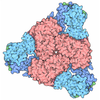[English] 日本語
 Yorodumi
Yorodumi- PDB-6g2i: Filament of acetyl-CoA carboxylase and BRCT domains of BRCA1 (ACC... -
+ Open data
Open data
- Basic information
Basic information
| Entry | Database: PDB / ID: 6g2i | ||||||||||||
|---|---|---|---|---|---|---|---|---|---|---|---|---|---|
| Title | Filament of acetyl-CoA carboxylase and BRCT domains of BRCA1 (ACC-BRCT) at 5.9 A resolution | ||||||||||||
 Components Components |
| ||||||||||||
 Keywords Keywords | LIGASE / Filament / Helical / Multienzyme / Biotin-dependent carboxylase | ||||||||||||
| Function / homology |  Function and homology information Function and homology informationhistone H2AK127 ubiquitin ligase activity / histone H2AK129 ubiquitin ligase activity / Defective DNA double strand break response due to BRCA1 loss of function / Defective DNA double strand break response due to BARD1 loss of function / BRCA1-BARD1 complex / acetyl-CoA carboxylase / BRCA1-B complex / BRCA1-A complex / BRCA1-C complex / negative regulation of centriole replication ...histone H2AK127 ubiquitin ligase activity / histone H2AK129 ubiquitin ligase activity / Defective DNA double strand break response due to BRCA1 loss of function / Defective DNA double strand break response due to BARD1 loss of function / BRCA1-BARD1 complex / acetyl-CoA carboxylase / BRCA1-B complex / BRCA1-A complex / BRCA1-C complex / negative regulation of centriole replication / fatty-acyl-CoA biosynthetic process / sex-chromosome dosage compensation / random inactivation of X chromosome / Defective HLCS causes multiple carboxylase deficiency / Biotin transport and metabolism / malonyl-CoA biosynthetic process / Fatty acyl-CoA biosynthesis / ubiquitin-modified histone reader activity / chordate embryonic development / nuclear ubiquitin ligase complex / cellular response to indole-3-methanol / gamma-tubulin ring complex / negative regulation of intracellular estrogen receptor signaling pathway / acetyl-CoA carboxylase activity / ChREBP activates metabolic gene expression / DNA strand resection involved in replication fork processing / negative regulation of fatty acid biosynthetic process / homologous recombination / Regulation of MITF-M-dependent genes involved in DNA replication, damage repair and senescence / acetyl-CoA metabolic process / tissue homeostasis / protein K6-linked ubiquitination / Carnitine shuttle / lateral element / regulation of DNA damage checkpoint / Impaired BRCA2 binding to PALB2 / XY body / mitotic G2/M transition checkpoint / RNA polymerase binding / DNA damage tolerance / DNA repair complex / centrosome cycle / Homologous DNA Pairing and Strand Exchange / Defective homologous recombination repair (HRR) due to BRCA1 loss of function / Defective HDR through Homologous Recombination Repair (HRR) due to PALB2 loss of BRCA1 binding function / Defective HDR through Homologous Recombination Repair (HRR) due to PALB2 loss of BRCA2/RAD51/RAD51C binding function / Resolution of D-loop Structures through Synthesis-Dependent Strand Annealing (SDSA) / Resolution of D-loop Structures through Holliday Junction Intermediates / HDR through Single Strand Annealing (SSA) / intracellular membraneless organelle / response to ionizing radiation / negative regulation of gene expression via chromosomal CpG island methylation / Impaired BRCA2 binding to RAD51 / Transcriptional Regulation by E2F6 / mitotic G2 DNA damage checkpoint signaling / lipid homeostasis / negative regulation of cell cycle / negative regulation of reactive oxygen species metabolic process / positive regulation of vascular endothelial growth factor production / Presynaptic phase of homologous DNA pairing and strand exchange / ubiquitin ligase complex / SUMOylation of DNA damage response and repair proteins / negative regulation of extrinsic apoptotic signaling pathway via death domain receptors / regulation of DNA repair / protein autoubiquitination / tubulin binding / Activation of gene expression by SREBF (SREBP) / Meiotic synapsis / positive regulation of DNA repair / cellular response to ionizing radiation / male germ cell nucleus / chromosome segregation / TP53 Regulates Transcription of DNA Repair Genes / Nonhomologous End-Joining (NHEJ) / negative regulation of cell growth / double-strand break repair via homologous recombination / G2/M DNA damage checkpoint / RING-type E3 ubiquitin transferase / HDR through Homologous Recombination (HRR) / Meiotic recombination / Metalloprotease DUBs / fibrillar center / positive regulation of angiogenesis / intrinsic apoptotic signaling pathway in response to DNA damage / ubiquitin-protein transferase activity / fatty acid biosynthetic process / cellular response to tumor necrosis factor / p53 binding / KEAP1-NFE2L2 pathway / cellular response to prostaglandin E stimulus / double-strand break repair / actin cytoskeleton / Recruitment and ATM-mediated phosphorylation of repair and signaling proteins at DNA double strand breaks / chromosome / Neddylation / Processing of DNA double-strand break ends / protein homotetramerization / Regulation of TP53 Activity through Phosphorylation / damaged DNA binding / transcription coactivator activity Similarity search - Function | ||||||||||||
| Biological species |  Homo sapiens (human) Homo sapiens (human) | ||||||||||||
| Method | ELECTRON MICROSCOPY / single particle reconstruction / cryo EM / Resolution: 5.9 Å | ||||||||||||
 Authors Authors | Hunkeler, M. / Hagmann, A. / Stuttfeld, E. / Chami, M. / Stahlberg, H. / Maier, T. | ||||||||||||
| Funding support |  Switzerland, 3items Switzerland, 3items
| ||||||||||||
 Citation Citation |  Journal: Nature / Year: 2018 Journal: Nature / Year: 2018Title: Structural basis for regulation of human acetyl-CoA carboxylase. Authors: Moritz Hunkeler / Anna Hagmann / Edward Stuttfeld / Mohamed Chami / Yakir Guri / Henning Stahlberg / Timm Maier /   Abstract: Acetyl-CoA carboxylase catalyses the ATP-dependent carboxylation of acetyl-CoA, a rate-limiting step in fatty acid biosynthesis. Eukaryotic acetyl-CoA carboxylases are large, homodimeric multienzymes. ...Acetyl-CoA carboxylase catalyses the ATP-dependent carboxylation of acetyl-CoA, a rate-limiting step in fatty acid biosynthesis. Eukaryotic acetyl-CoA carboxylases are large, homodimeric multienzymes. Human acetyl-CoA carboxylase occurs in two isoforms: the metabolic, cytosolic ACC1, and ACC2, which is anchored to the outer mitochondrial membrane and controls fatty acid β-oxidation. ACC1 is regulated by a complex interplay of phosphorylation, binding of allosteric regulators and protein-protein interactions, which is further linked to filament formation. These filaments were discovered in vitro and in vivo 50 years ago, but the structural basis of ACC1 polymerization and regulation remains unknown. Here, we identify distinct activated and inhibited ACC1 filament forms. We obtained cryo-electron microscopy structures of an activated filament that is allosterically induced by citrate (ACC-citrate), and an inactivated filament form that results from binding of the BRCT domains of the breast cancer type 1 susceptibility protein (BRCA1). While non-polymeric ACC1 is highly dynamic, filament formation locks ACC1 into different catalytically competent or incompetent conformational states. This unique mechanism of enzyme regulation via large-scale conformational changes observed in ACC1 has potential uses in engineering of switchable biosynthetic systems. Dissecting the regulation of acetyl-CoA carboxylase opens new paths towards counteracting upregulation of fatty acid biosynthesis in disease. | ||||||||||||
| History |
|
- Structure visualization
Structure visualization
| Movie |
 Movie viewer Movie viewer |
|---|---|
| Structure viewer | Molecule:  Molmil Molmil Jmol/JSmol Jmol/JSmol |
- Downloads & links
Downloads & links
- Download
Download
| PDBx/mmCIF format |  6g2i.cif.gz 6g2i.cif.gz | 5.9 MB | Display |  PDBx/mmCIF format PDBx/mmCIF format |
|---|---|---|---|---|
| PDB format |  pdb6g2i.ent.gz pdb6g2i.ent.gz | Display |  PDB format PDB format | |
| PDBx/mmJSON format |  6g2i.json.gz 6g2i.json.gz | Tree view |  PDBx/mmJSON format PDBx/mmJSON format | |
| Others |  Other downloads Other downloads |
-Validation report
| Arichive directory |  https://data.pdbj.org/pub/pdb/validation_reports/g2/6g2i https://data.pdbj.org/pub/pdb/validation_reports/g2/6g2i ftp://data.pdbj.org/pub/pdb/validation_reports/g2/6g2i ftp://data.pdbj.org/pub/pdb/validation_reports/g2/6g2i | HTTPS FTP |
|---|
-Related structure data
| Related structure data |  4344MC  4342C  4343C  6g2dC  6g2hC C: citing same article ( M: map data used to model this data |
|---|---|
| Similar structure data |
- Links
Links
- Assembly
Assembly
| Deposited unit | 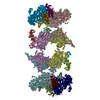
|
|---|---|
| 1 |
|
- Components
Components
| #1: Protein | Mass: 265949.344 Da / Num. of mol.: 10 Source method: isolated from a genetically manipulated source Source: (gene. exp.)  Homo sapiens (human) / Gene: ACACA, ACAC, ACC1, ACCA / Production host: Homo sapiens (human) / Gene: ACACA, ACAC, ACC1, ACCA / Production host:  References: UniProt: Q13085, acetyl-CoA carboxylase, biotin carboxylase #2: Protein | Mass: 27664.869 Da / Num. of mol.: 8 Source method: isolated from a genetically manipulated source Source: (gene. exp.)  Homo sapiens (human) / Gene: BRCA1, RNF53 / Production host: Homo sapiens (human) / Gene: BRCA1, RNF53 / Production host:  References: UniProt: P38398, RING-type E3 ubiquitin transferase Has protein modification | Y | |
|---|
-Experimental details
-Experiment
| Experiment | Method: ELECTRON MICROSCOPY |
|---|---|
| EM experiment | Aggregation state: FILAMENT / 3D reconstruction method: single particle reconstruction |
- Sample preparation
Sample preparation
| Component |
| ||||||||||||||||||||||||
|---|---|---|---|---|---|---|---|---|---|---|---|---|---|---|---|---|---|---|---|---|---|---|---|---|---|
| Source (natural) |
| ||||||||||||||||||||||||
| Source (recombinant) |
| ||||||||||||||||||||||||
| Buffer solution | pH: 8 | ||||||||||||||||||||||||
| Specimen | Embedding applied: NO / Shadowing applied: NO / Staining applied: NO / Vitrification applied: YES | ||||||||||||||||||||||||
| Vitrification | Cryogen name: ETHANE |
- Electron microscopy imaging
Electron microscopy imaging
| Experimental equipment |  Model: Titan Krios / Image courtesy: FEI Company |
|---|---|
| Microscopy | Model: FEI TITAN KRIOS |
| Electron gun | Electron source:  FIELD EMISSION GUN / Accelerating voltage: 300 kV / Illumination mode: FLOOD BEAM FIELD EMISSION GUN / Accelerating voltage: 300 kV / Illumination mode: FLOOD BEAM |
| Electron lens | Mode: BRIGHT FIELD |
| Image recording | Electron dose: 1 e/Å2 / Film or detector model: GATAN K2 SUMMIT (4k x 4k) Details: Collected in movie-mode with total dose of 80 e-/A2 for a total of 80 frames. Frames 3-22 were used for final reconstruction |
- Processing
Processing
| Software |
| ||||||||||||||||||||||||
|---|---|---|---|---|---|---|---|---|---|---|---|---|---|---|---|---|---|---|---|---|---|---|---|---|---|
| EM software |
| ||||||||||||||||||||||||
| CTF correction | Type: PHASE FLIPPING AND AMPLITUDE CORRECTION | ||||||||||||||||||||||||
| Symmetry | Point symmetry: C2 (2 fold cyclic) | ||||||||||||||||||||||||
| 3D reconstruction | Resolution: 5.9 Å / Resolution method: FSC 0.143 CUT-OFF / Num. of particles: 48483 / Symmetry type: POINT | ||||||||||||||||||||||||
| Refinement | Stereochemistry target values: GeoStd + Monomer Library | ||||||||||||||||||||||||
| Refine LS restraints |
|
 Movie
Movie Controller
Controller


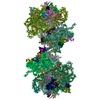
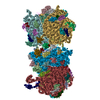
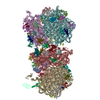
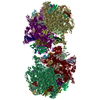

 PDBj
PDBj

